Do your teams understand your strategy?
We often find that organisations are good at creating their strategy; senior teams can get together, articulate where they’re going and what difference taking a certain approach will make. They really ‘get it’ and they feel connected to it.
But equally, our experience shows the difficulty comes in translating that strategy into something meaningful and tangible that others within the organisation will understand and connect with. That is, taking everyone on the same journey, from awareness to understanding to implementation.
It’s not that other people don’t have the ability to “get it”, they perhaps don’t have the same enthusiasm – usually because the strategy isn’t clearly and concisely communicated. It may not even answer the most important question of all: ‘What’s in it for me?’
Strategy
Translating strategy at a task level is fundamental to its success. What does that mean for Nick in finance? What does he need to do differently to play his part? Executive teams can often miss the opportunity to translate their strategic plan into an implementation plan.
Excuse the cliché, but there’s a real need to have a thread that runs through a business that allows people to see where they’re going, understand the part they play and how this affects what they do on a daily and weekly basis.
The approach we recommend is a structured way of connecting your strategy all the way through your business to the objectives of individual team members.
If we take Nick from finance as our example again, he should know what he personally has to do at a task level to impact the finance team, his division and also the business. Our Ignite Change – Take Action Handbook guides clients this in a visual way, so that on a one-page document, Nick can see the thread that links what he does all the way through the business to the divisional objectives and finally up to organisational goals.
Communication
We’ve struggled to find evidence behind this fact, but there’s an old adage that you have to tell someone something 7 times before the can hear it. There’s a need to communicate your key messages, as many times as you can, in as many different ways as possible.
We use one-page visual ‘compelling strategic narratives’ accompanied by plans for every department and ultimately every individual. The same strategic messages need to continue to be reinforced. Taking a fresh approach to communicating these messages (as an email is not enough!) is really important, so for example we use roadshows, townhall meetings, workshops, playbooks, letters to home and even air fresheners with plan on!
There’s also a place for the usual intranets, Sharepoint, Slack and Teams to keep the messages ‘live’ on a daily or task basis.
Engage
Strategy can seem complex or remote from some employees. Simplify it and involve them. It will empower them to deliver it.
When Exec teams create strategies they look forwards. They don’t necessarily need to have the skills or knowledge to determine how that strategy should be implemented at a really granular level of detail. We have used this approach to spend time with people at all levels of the organisation to ask “how should we do this?”
In one of our case studies, in the health sector, we spent time with experts in one clinical area. They saw the strategy and understood the direction they needed to take. They were asked what they would do to achieve those goals in their area. They knew the frustrations that both they, and their patients had with the current approach and they offered an alternative approach. Their plan still met the organisational goal; still worked towards the same target, but took a far more pragmatic and patient focused route. The teams were clear that no extra cost to be added (in fact, ideally, cost would reduce), but the quality and access targets were still crucial. “Their way” showed that there was a better way and the results proved it! They had higher engagement from ‘at risk’ service users, and the teams were more engaged as a result.
It’s an inspirational part of the approach as people feel genuinely engaged. They have the opportunity to be part of a bigger plan. It makes it real for them and they also feel much more connected to delivering ideas which may have been theirs.
It’s simple!








